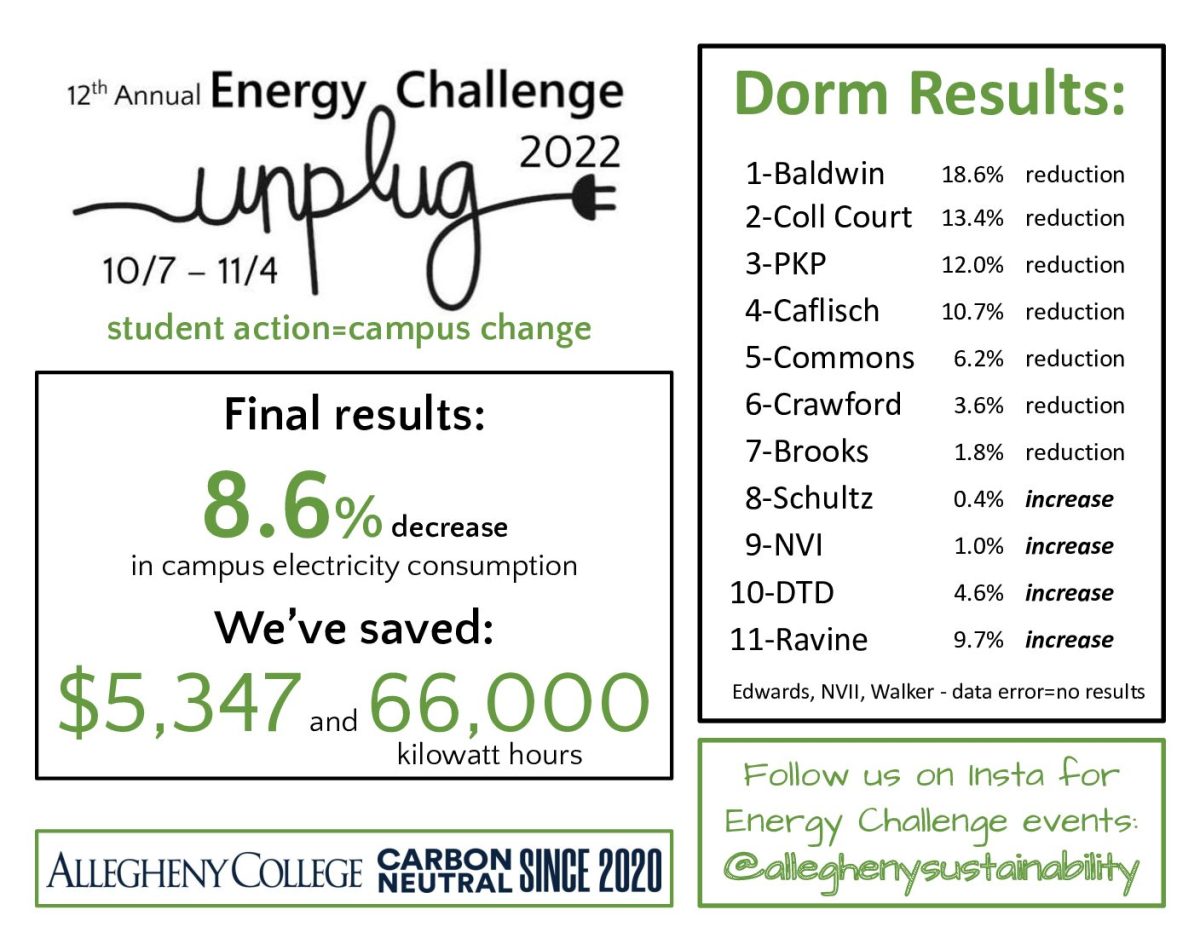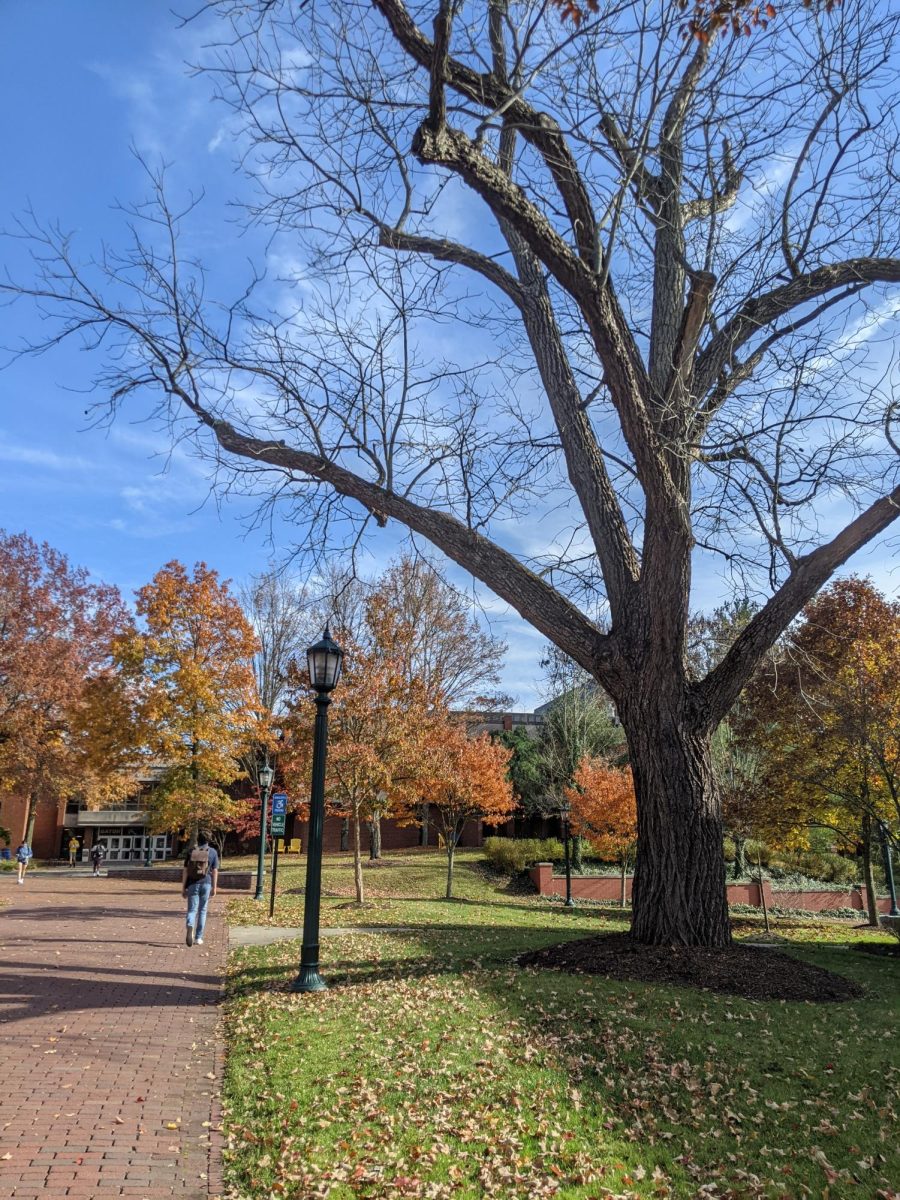Taped to the doors of each dorm hall, there is a piece of paper that lists out how much every dorm hall has reduced their energy consumption and how much money has been saved. Every year during October — National Clean Energy Action Month — Allegheny College encourages its students to reduce their energy consumption for one month to see how much money and electricity they can save.
Students might see the information on the posters, but students do not see how that information is recorded.
“We read submeters and electric meters to calculate a baseline directly preceding the challenge for both individual buildings and campus as a whole,” said Director of Sustainability Kelly Boulton, ’02. “Once the challenge begins, we read the submeters and electric meters weekly and enter data in a spreadsheet which is designed to calculate the use for the week and then compare that to the baseline to determine the percent change for that building and for the campus overall.”
Though it is referred to as a challenge, it is not a competition between dorms. Instead, it is a campus-wide effort to reduce the college’s energy consumption, according to Boulton.
But not every hall is strictly used for student living. Brooks Hall is attached to the dining hall, and Schultz Hall has a banquet space, health center and several administrative offices. For this reason, the Office of Sustainability displays the results as a reduction percentage.
“That’s why we do all of the results in percent reduction because it helps normalize,” Boulton said. “We are more focused on the overall results for the campus and everyone contributing to that, rather than putting all the dorms against each other.”
Trying to conserve energy this month is about all students working together to be more sustainable, as well as saving money that could go towards more efforts to become a more environmentally-conscious campus. The emphasis is on the community, Boulton said.
This year will mark the 13th time the challenge has been conducted since its introduction in 2010. It slowed down during the COVID-19 pandemic, so it is not as well-known to the student body as it has been in the past. Because of that, Boulton wants more students to be aware of the challenge.
“Turning off lights when you leave your room, maybe not leaving a fan running when you’re gone, turning off Christmas lights, shutting down computers at night, unplugging chargers, even gaming systems,” Boulton said.
These methods of conserving energy are especially important as the challenge helps students start to understand the link between energy usage and money, which will prepare students for their life after college.
“The whole thing is designed to encourage students to do that, recognize where there are possibilities, see how individual action can add up to cumulative impact,” Boulton said.
But the energy conservation is not isolated to just October. Looking at energy usage on campus in the years before the challenge and comparing it to now, the energy usage never gets as high as it used to before 2010.
“In the years that we have done the challenge, it never bumps as much as it did, so ideally students are incorporating it in.” Boulton said. “We really just encourage people that they do not have to sit in their individual rooms without the lights on, go to common areas and gather.”
This year, Students for Environmental Action plan on continuing their yearly tradition of baking homegrown potatoes on an open fire, according SEA President Julia Sonen, ‘24. Students can gather and enjoy a meal that does not use any electricity.
“The energy challenge really does work,” Sonen said. “Last year, we raised enough money to half-fund a green box machine and ASG matched it, so we got an extra green box machine–there used to be only one on campus. In the past, they have put up solar panels on Steffee, and this is just with the savings on campus. When we work together, we create change.”
The October challenge is meant to bring students together whether that’s through events hosted by clubs, gathering where there is always light or reducing energy usage by just turning off lights.
“The goal for this year is to build it back up, to make it more fun and recognize that work actually contributes to the college’s sustainability goals,” said Boulton.
The money saved even goes back to the students, usually towards projects that will make the campus more sustainable. It is about making an impact on our environment on a small scale.
Categories:
October Energy Challenge is back for the 13th year
Story continues below advertisement
0
More to Discover








